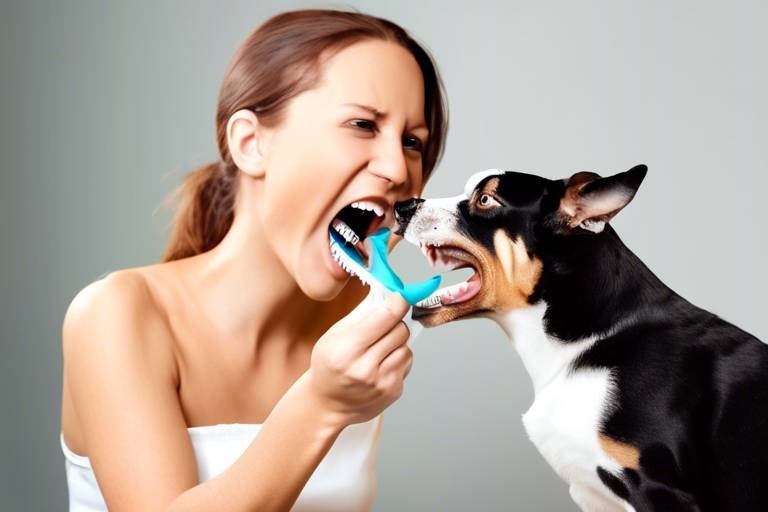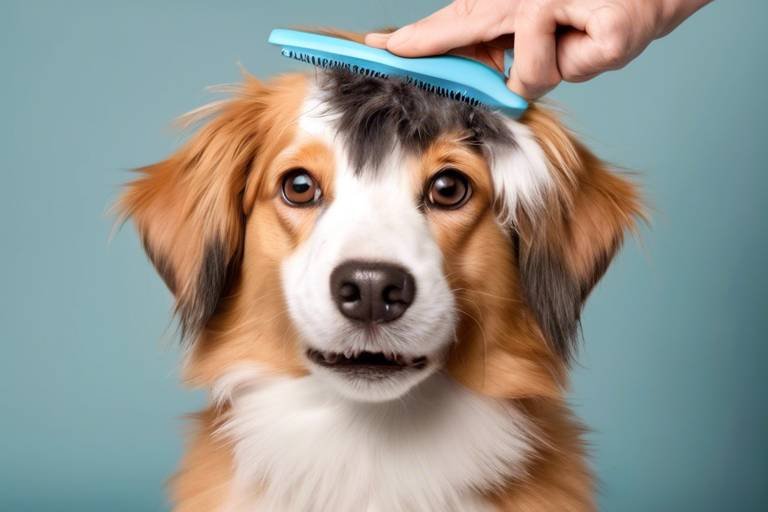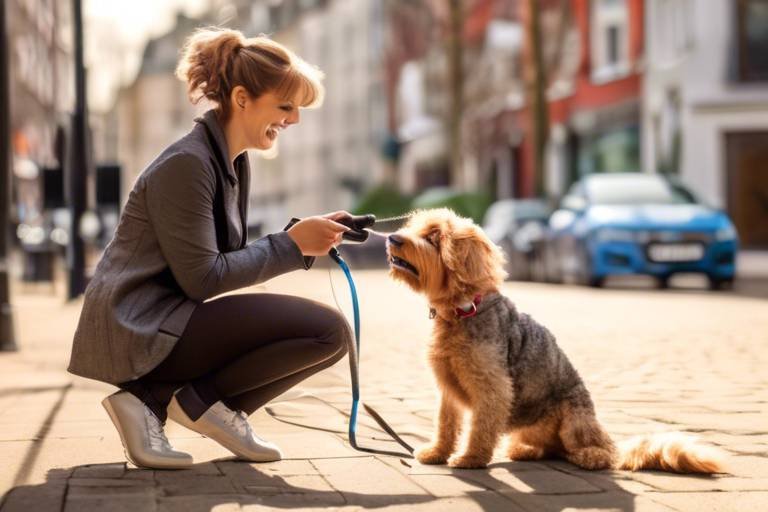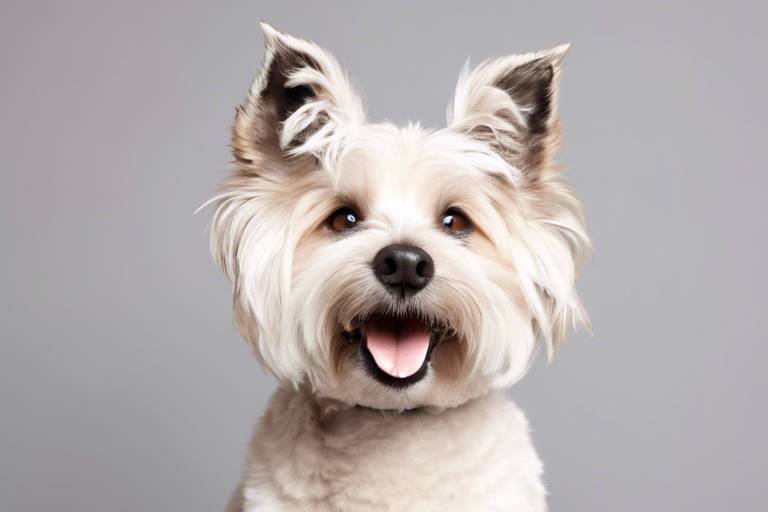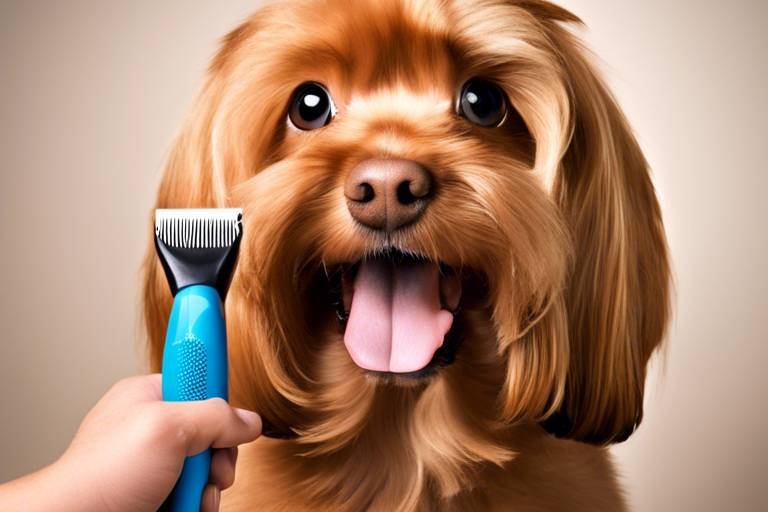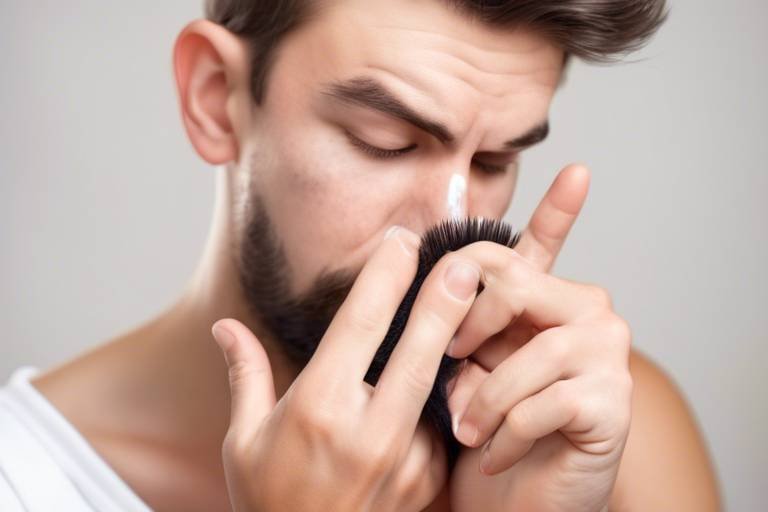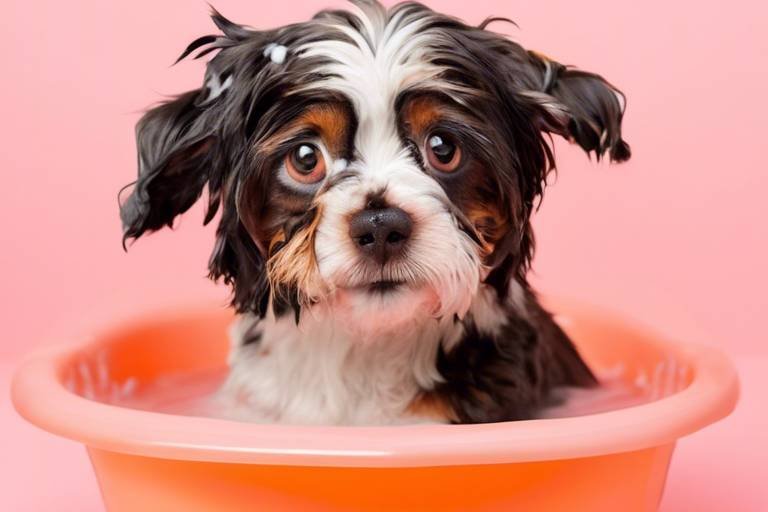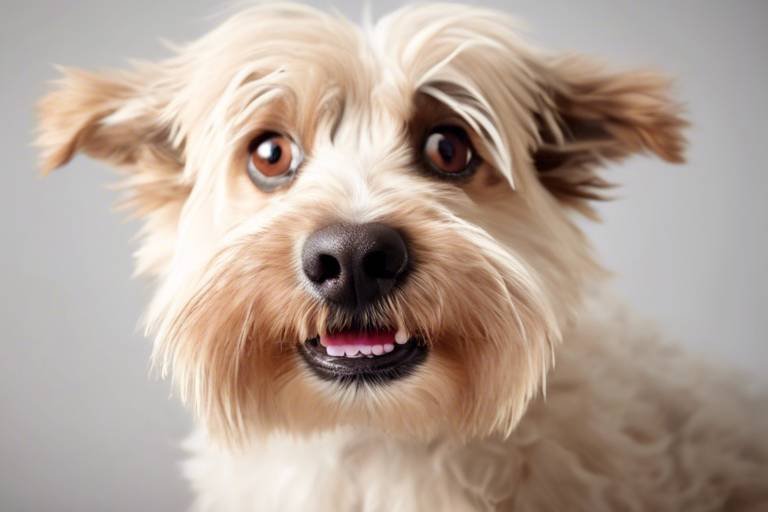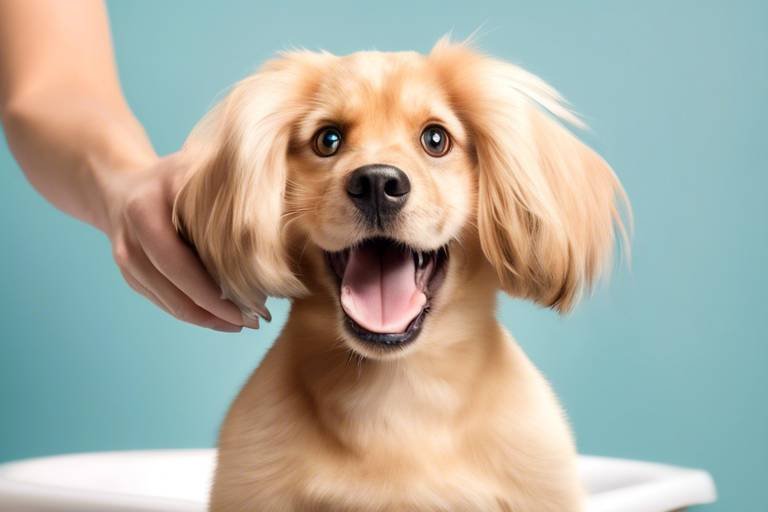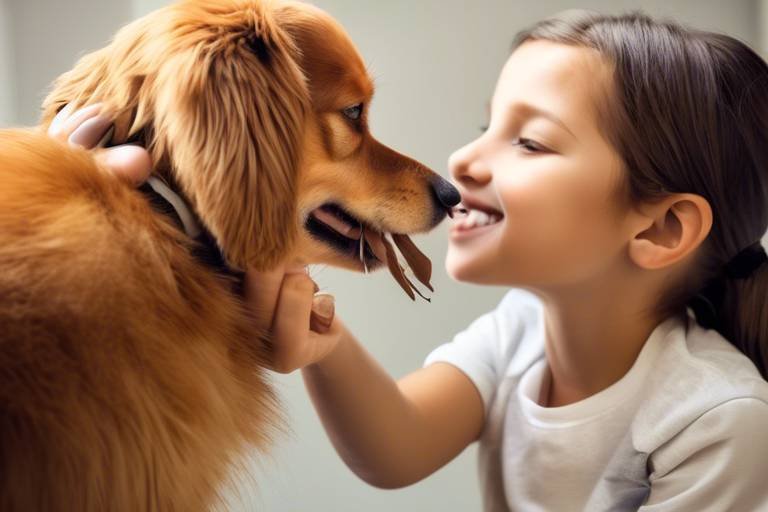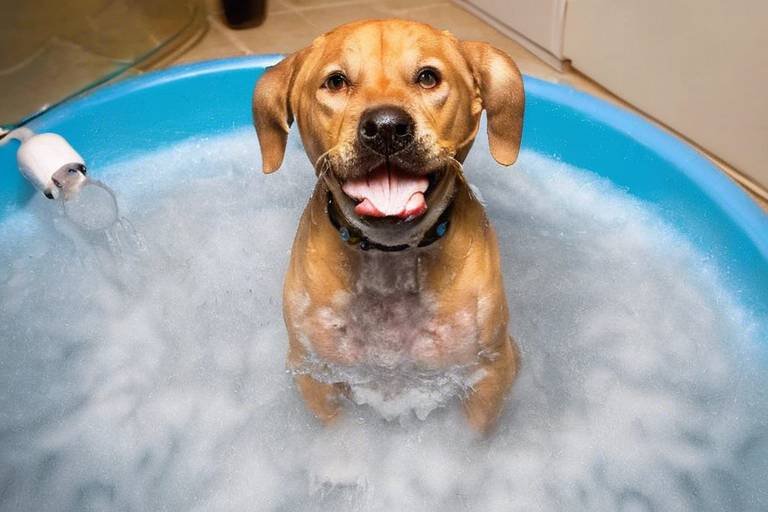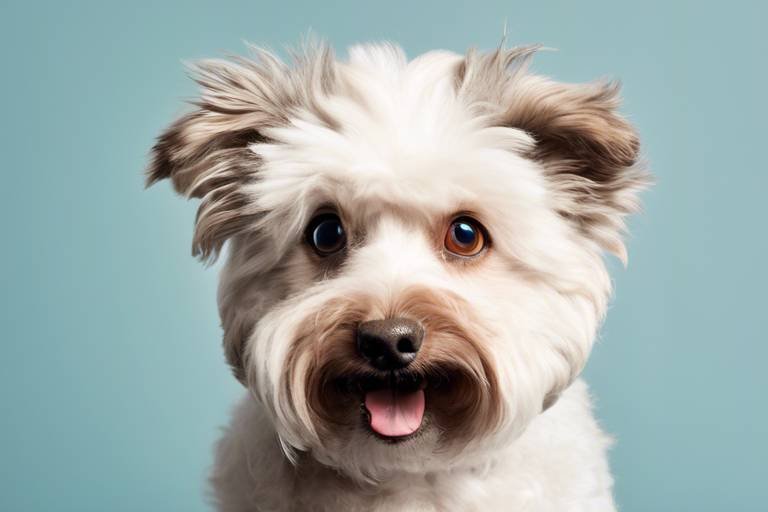Tips for Grooming a Pet with Separation Anxiety
Grooming your beloved pet can be a delightful experience, but for those furry friends grappling with separation anxiety, it can feel like an uphill battle. Imagine trying to calm a stormy sea; that’s what it can be like when your pet is anxious. The good news is that with a little understanding and the right approach, you can turn grooming into a positive and relaxing experience for both you and your pet. In this article, we’ll dive into some essential tips that will help you navigate the grooming process while keeping your anxious pet comfortable and calm.
Separation anxiety in pets is no small matter. It can lead to a host of stress-related behaviors, from excessive barking to destructive chewing. Recognizing the signs of anxiety, such as pacing, whining, or hiding, is crucial for managing your pet’s needs effectively. Just like humans, pets can feel overwhelmed when left alone, and grooming can sometimes amplify these feelings. By creating a supportive environment, you can help minimize anxiety triggers and make grooming a more enjoyable experience.
Preparation is key to a successful grooming session. Think of it as setting the stage for a performance; everything needs to be just right. Establishing a routine can work wonders. Try to groom your pet at the same time every week, so they know what to expect. Additionally, creating a comfortable space is essential. Choose a quiet area in your home where your pet feels safe, away from loud noises and distractions. This can significantly reduce their anxiety levels and help them feel more at ease.
Having the right grooming tools is like having the right ingredients for a recipe; it can make all the difference. Soft brushes and gentle clippers are your best friends when it comes to soothing anxious pets. The right tools not only make the process smoother but also help your pet feel more comfortable. A good rule of thumb is to select tools that are specifically designed for sensitive animals. This attention to detail can transform a potentially stressful grooming session into a calm and enjoyable experience.
When it comes to brushes, different types serve various purposes. For sensitive pets, opt for brushes with softer bristles. These brushes can prevent discomfort and promote relaxation during the grooming process. Imagine how soothing it feels to have a gentle massage; that’s what a soft brush can do for your furry friend.
Using quiet clippers can significantly reduce anxiety in pets. Look for low-noise options designed specifically for sensitive animals. The sound of traditional clippers can be jarring, akin to a loud alarm clock that startles you awake. Choosing quieter alternatives can help create a calmer environment, allowing your pet to relax and trust you more during grooming.
A consistent grooming routine can help pets feel secure. Just like we thrive on routine, our pets do too! Regular sessions at the same time and place create familiarity, which can reduce anxiety and make grooming a more pleasant experience. Think of it as building a bridge of trust between you and your pet; the more you groom them regularly, the stronger that bridge becomes.
Incorporating positive reinforcement can transform grooming into a rewarding experience. Just like a child who receives praise for good behavior, your pet will respond positively to treats, praise, and gentle encouragement. This approach not only alleviates anxiety but also strengthens the bond between you and your furry friend. Remember, every little bit of encouragement counts!
Offering treats during grooming can create positive associations. Gradually introduce treats at each grooming step to reinforce calm behavior. For example, give your pet a treat when they sit still or allow you to brush a specific area. This method is like giving a high-five for a job well done, helping them understand that grooming can be a fun and rewarding experience.
Creating a tranquil environment is essential for anxious pets. Soft music, dim lighting, and minimal distractions can help soothe them, making grooming sessions more manageable and enjoyable. Think of it as setting up a cozy nook; the more comfortable and inviting the space, the more relaxed your pet will be.
Sometimes, professional help may be necessary for pets with severe separation anxiety. If your pet’s anxiety seems overwhelming, it’s important to consult a veterinarian or a pet behaviorist. They can provide tailored advice and strategies to ensure the best care for your furry friend. Remember, seeking help is not a sign of failure; it’s a proactive step towards improving your pet’s quality of life.
- What are the signs of separation anxiety in pets? Look for signs such as excessive barking, destructive behavior, or hiding when left alone.
- How can I create a calming environment for grooming? Use soft music, dim lighting, and choose a quiet space to reduce distractions.
- When should I consider professional help for my pet's anxiety? If your pet shows severe anxiety that affects their daily life, consult a veterinarian or a pet behaviorist.

Understanding Separation Anxiety
Separation anxiety is a common issue that many pets face, particularly dogs and cats. It occurs when a pet becomes overly attached to their owner and experiences significant distress when left alone. This can lead to a range of behavioral problems, including excessive barking, destructive chewing, and even house soiling. Recognizing the signs of separation anxiety is crucial for effective management. Some typical signs include:
- Excessive vocalization, such as barking or meowing.
- Destructive behavior, like chewing furniture or scratching doors.
- Inappropriate elimination, where pets urinate or defecate indoors despite being house-trained.
- Pacing or restlessness, indicating anxiety and discomfort.
- Salivating or drooling excessively when left alone.
Understanding these signs can help you create a supportive grooming environment that minimizes anxiety triggers. For instance, knowing when your pet is feeling anxious can guide you in choosing the right time for grooming sessions. This understanding allows you to approach grooming not just as a task, but as an opportunity to provide comfort and care to your furry friend.
Moreover, separation anxiety can stem from various factors, including changes in the household, loss of a family member, or even a lack of socialization. It's essential to consider these factors when planning grooming sessions. A pet that is already stressed due to other circumstances may find grooming overwhelming. Therefore, creating a calm and reassuring atmosphere is vital to help alleviate their anxiety.
In summary, understanding separation anxiety is the first step towards providing effective care for your pet. By recognizing the signs and being mindful of their emotional state, you can create a more positive grooming experience that not only maintains their hygiene but also strengthens the bond you share.

Preparing for Grooming Sessions
When it comes to grooming a pet with separation anxiety, preparation is everything. Think of it like preparing for a big presentation; you wouldn’t walk in unprepared, right? Similarly, your furry friend deserves a well-planned grooming session that minimizes their stress and maximizes their comfort. The first step is to establish a consistent routine. Pets thrive on predictability, and knowing when and where grooming will take place can significantly reduce their anxiety levels. Choose a specific time of day that works for both you and your pet, and try to stick to it as closely as possible.
Next, create a comfortable space for grooming. This area should be quiet, free from distractions, and familiar to your pet. Perhaps it’s a cozy corner of your living room or a designated grooming spot in the backyard. Whatever the case, ensure the environment is soothing. You might even consider adding a soft blanket or a favorite toy to make the space feel more inviting. Remember, a calm pet is a happy pet, and a happy pet is much easier to groom!
It’s also essential to gather all the necessary grooming supplies ahead of time. Imagine trying to cook a meal without all your ingredients; it can be chaotic! Similarly, having everything you need on hand will streamline the grooming process. Here’s a quick checklist of items you might need:
- Soft brushes
- Gentle clippers
- Pet-friendly shampoo
- Towels
- Treats for positive reinforcement
By preparing your grooming area and gathering your tools, you set the stage for a more relaxed experience. Additionally, consider incorporating some calming techniques before starting the grooming session. This could include playing soft music or using pheromone sprays designed to soothe anxious pets. Just as a cozy atmosphere can help humans relax, it can do wonders for our furry companions too!
Lastly, don’t forget to take breaks during the grooming process. If your pet seems overwhelmed, pause for a moment, give them a gentle pat, and perhaps offer a treat. This not only helps ease their anxiety but also reinforces the idea that grooming can be a positive experience. Remember, patience is key! With a little preparation and understanding, you can turn grooming into a bonding experience rather than a stressful chore.
Choosing the Right Tools
When it comes to grooming pets with separation anxiety, selecting the right tools is absolutely essential. Just like a painter needs the right brushes to create a masterpiece, you need the appropriate grooming tools to ensure a calm and positive experience for your furry friend. Imagine trying to paint a delicate landscape with a heavy-duty brush; it just wouldn't work! Similarly, using harsh or intimidating grooming tools can exacerbate your pet's anxiety, making the process a nightmare for both of you.
To create a soothing grooming environment, start by investing in soft brushes and gentle clippers. These tools not only help to minimize discomfort but also promote relaxation. For instance, a soft-bristle brush can feel like a gentle massage, while a loud clipper can sound like a roaring monster. It’s crucial to choose tools that cater to your pet's specific needs, especially if they have sensitive skin or are easily startled.
Here’s a quick overview of some grooming tools that can help ease your pet’s anxiety:
| Tool Type | Description | Benefits |
|---|---|---|
| Soft Brushes | Brushes with gentle bristles that do not irritate the skin. | Promotes relaxation and comfort during grooming. |
| Quiet Clippers | Low-noise clippers designed for sensitive pets. | Reduces fear and anxiety associated with loud sounds. |
| Grooming Gloves | Gloves with rubber bristles that allow for gentle grooming. | Provides a comforting touch while removing loose fur. |
In addition to these tools, consider the grooming environment itself. A well-lit, quiet space can make a world of difference. Think of it as setting the stage for a calming performance. By eliminating distractions and creating a serene atmosphere, you can help your pet feel more at ease. Remember, the goal is to transform grooming from a stressful chore into a bonding experience.
Ultimately, the right tools can empower you to groom your pet effectively while keeping their anxiety levels in check. So, take your time to choose wisely, and don’t hesitate to seek advice from professionals if you're unsure which tools are best suited for your furry companion.
- What are the signs of separation anxiety in pets? Look for excessive barking, destructive behavior, and signs of distress when you leave the house.
- How often should I groom my pet? It depends on the breed and coat type, but regular grooming every few weeks is generally recommended.
- Can grooming help reduce my pet's anxiety? Yes, a calm grooming routine can help your pet feel more secure and relaxed.
- What if my pet still shows signs of anxiety during grooming? Consider consulting a veterinarian or a pet behaviorist for tailored advice and support.
Brush Types for Sensitive Pets
When it comes to grooming our furry friends, especially those with sensitive skin or heightened anxiety, choosing the right brush is absolutely crucial. A proper brush not only helps maintain your pet’s hygiene but also enhances their comfort, turning grooming from a daunting task into a delightful bonding experience. Imagine how you feel when someone gently brushes your hair; it’s soothing, right? Our pets deserve that same level of care and consideration.
There are several types of brushes available, each designed to cater to different coat types and sensitivities. Here’s a quick overview of some popular options:
| Brush Type | Description | Best For |
|---|---|---|
| Slicker Brush | Features fine, short wires close together to remove mats and tangles. | Long-haired breeds or pets with thick fur. |
| Soft Bristle Brush | Made with soft bristles, perfect for gentle grooming. | Short-haired breeds and pets with sensitive skin. |
| Rubber Brush | Has rubber bristles that massage the skin while removing loose fur. | All coat types, especially for pets that enjoy a good rub. |
| Undercoat Rake | Designed to reach the undercoat without damaging the top coat. | Double-coated breeds that shed heavily. |
For pets with heightened sensitivity, the soft bristle brush is often the best choice. Its gentle touch can make all the difference, allowing your pet to relax while you groom them. Additionally, the rubber brush is a fantastic option for pets who may be skittish. The massaging effect not only helps remove loose hair but also provides a comforting sensation that can calm anxious pets.
It's essential to introduce the brush gradually. Start by letting your pet sniff and explore the brush before you begin grooming. This simple step can help them associate the brush with positive experiences rather than anxiety. Remember, patience is key! If your pet starts to show signs of discomfort, take a break and try again later.
In conclusion, selecting the right brush for your sensitive pet is a vital part of the grooming process. By understanding their needs and preferences, you can create a more enjoyable grooming experience that fosters trust and relaxation. After all, grooming should be a time for bonding and love, not stress and anxiety!
Clippers and Trimmers
This article provides essential tips for grooming pets suffering from separation anxiety, helping owners create a calm and positive experience for their furry friends while maintaining their hygiene and appearance.
Separation anxiety in pets can lead to stress and behavioral issues. Recognizing the signs is crucial for effective management and creating a supportive grooming environment that minimizes anxiety triggers.
Preparation is key to a successful grooming session. Establishing a routine and creating a comfortable space can help reduce anxiety, making the experience more enjoyable for both the pet and the owner.
Selecting appropriate grooming tools is vital for a stress-free experience. Soft brushes and gentle clippers can help soothe anxious pets, making them feel more comfortable during grooming sessions.
When it comes to grooming pets with separation anxiety, the right can make all the difference. It’s not just about keeping your pet looking sharp; it's about ensuring their comfort and reducing the stress associated with grooming. Anxious pets can react negatively to loud noises, so choosing quiet clippers is essential. Look for models specifically designed for sensitive animals, as these tend to operate at lower decibels, minimizing fear and discomfort.
Additionally, consider the design of the clipper. Ergonomic handles can make it easier for you to maneuver, allowing for a smoother grooming process. This is especially important when your pet is anxious, as any sudden movements can exacerbate their stress. You might also want to look for clippers with adjustable speed settings, which allow you to start slow and gradually increase the speed as your pet becomes more comfortable.
Here’s a quick overview of some features to look for when choosing clippers and trimmers:
| Feature | Importance |
|---|---|
| Low Noise | Reduces anxiety during grooming |
| Ergonomic Design | Enhances control and comfort for the groomer |
| Adjustable Speed | Allows gradual acclimation for anxious pets |
| Safety Features | Prevents accidental cuts and injuries |
In addition to clippers, you might also want to invest in a good set of trimmers. Trimmers are excellent for detailing and can help you reach those tricky spots that clippers might miss. They’re also typically quieter than clippers, which can be a bonus for pets that are particularly skittish. When using trimmers, make sure they are designed for pets, as human trimmers can be too harsh and may cause discomfort.
Ultimately, the goal is to create a grooming experience that feels safe and positive for your furry friend. By choosing the right clippers and trimmers, you can significantly reduce the stress associated with grooming, helping your pet look and feel their best.
Incorporating positive reinforcement can transform grooming into a rewarding experience. Treats, praise, and gentle encouragement can help alleviate anxiety and build trust between the pet and owner.
Offering treats during grooming can create positive associations. Gradually introduce treats at each grooming step to reinforce calm behavior and reduce anxiety.
Creating a tranquil environment is essential. Soft music, dim lighting, and minimal distractions can help soothe anxious pets, making grooming sessions more manageable and enjoyable for everyone involved.
Sometimes, professional help may be necessary for pets with severe separation anxiety. Understanding when to consult a veterinarian or a pet behaviorist can ensure the best care for your furry friend.
- What are the signs of separation anxiety in pets? Look for behaviors like excessive barking, destructive chewing, or attempts to escape when left alone.
- How can I help my pet feel more comfortable during grooming? Establish a routine, use calming tools, and provide positive reinforcement like treats and praise.
- When should I consider professional help? If your pet's anxiety is severe and you’re unable to manage it at home, consult a veterinarian or pet behaviorist.
Establishing a Routine
This article provides essential tips for grooming pets suffering from separation anxiety, helping owners create a calm and positive experience for their furry friends while maintaining their hygiene and appearance.
Separation anxiety in pets can lead to stress and behavioral issues. Recognizing the signs is crucial for effective management and creating a supportive grooming environment that minimizes anxiety triggers.
Preparation is key to a successful grooming session. Establishing a routine and creating a comfortable space can help reduce anxiety, making the experience more enjoyable for both the pet and the owner.
Selecting appropriate grooming tools is vital for a stress-free experience. Soft brushes and gentle clippers can help soothe anxious pets, making them feel more comfortable during grooming sessions.
Different brush types serve various purposes. For sensitive pets, opt for softer bristles that prevent discomfort and promote relaxation during the grooming process.
Using quiet clippers can significantly reduce anxiety in pets. Look for low-noise options designed specifically for sensitive animals to minimize fear during grooming.
Creating a consistent grooming routine is one of the most effective ways to help your pet feel secure and relaxed during grooming sessions. Just like us, pets thrive on familiarity and predictability. When they know what to expect, they can approach the experience with less anxiety and more confidence. Start by picking a specific time of day for grooming, whether it’s in the morning before breakfast or in the evening after a walk. Consistency is key!
Additionally, consider setting up a dedicated grooming area that is quiet and free from distractions. This space should be associated with positive experiences, so try to keep it calm and inviting. You might want to include their favorite blanket or a comfortable mat where they can sit. When your pet sees this familiar setup, they’ll start to associate it with routine and comfort.
To further reinforce this routine, you can incorporate the following elements:
- Visual Cues: Use specific cues or signals that indicate it’s grooming time. This could be a gentle call or even a specific toy that you only bring out during grooming.
- Duration: Keep grooming sessions short initially to prevent overwhelming your pet. Gradually increase the time as they become more accustomed to the process.
- Post-Grooming Rewards: After every grooming session, reward your pet with a treat or playtime. This helps to create a positive association with the routine.
Remember, patience is essential. If your pet shows signs of distress, take a step back and allow them to adjust. Over time, with a solid routine, your furry friend will learn that grooming is just another part of their day, and they can handle it with ease.
Incorporating positive reinforcement can transform grooming into a rewarding experience. Treats, praise, and gentle encouragement can help alleviate anxiety and build trust between the pet and owner.
Offering treats during grooming can create positive associations. Gradually introduce treats at each grooming step to reinforce calm behavior and reduce anxiety.
Creating a tranquil environment is essential. Soft music, dim lighting, and minimal distractions can help soothe anxious pets, making grooming sessions more manageable and enjoyable for everyone involved.
Sometimes, professional help may be necessary for pets with severe separation anxiety. Understanding when to consult a veterinarian or a pet behaviorist can ensure the best care for your furry friend.
Common signs include excessive barking, destructive behavior, and attempts to escape when left alone. They may also exhibit signs of distress such as drooling or pacing.
Establish a routine, use positive reinforcement, and create a calm environment to help your pet feel more secure when you are not around.
If your pet's anxiety is severe or persistent, consulting a veterinarian or a certified animal behaviorist can provide tailored strategies and possible treatment options.

Positive Reinforcement Techniques
When it comes to grooming pets with separation anxiety, positive reinforcement can work wonders. Imagine you’re trying to convince a shy child to participate in a fun activity. You wouldn’t force them, right? Instead, you’d gently encourage them, perhaps with a reward or a kind word. The same principle applies to our furry friends. By incorporating treats, praise, and gentle encouragement into the grooming process, you can transform what might be a stressful experience into a rewarding adventure for your pet.
One effective way to use positive reinforcement is by offering treats at each step of the grooming process. Start with simple tasks, like brushing a small section of fur, and immediately reward your pet with a treat. This creates a positive association with grooming. Over time, your pet will begin to associate grooming with tasty rewards, making them more relaxed and willing to participate. It’s like training a puppy to sit: consistent rewards lead to positive behavior!
In addition to treats, verbal praise is incredibly powerful. Use a calm and soothing voice to reassure your pet as you groom them. Phrases like “Good boy!” or “You’re doing so well!” can make a significant difference. Just like humans, pets thrive on affirmation. When they hear encouraging words, they feel more secure and less anxious, which can turn a potentially stressful grooming session into a bonding experience.
Setting the stage for a calm environment is also crucial. Consider playing some soft music or using a white noise machine to drown out any sudden noises that might startle your pet. A tranquil setting can help soothe their nerves, allowing them to focus on the positive reinforcement rather than the anxiety of grooming. Think of it as creating a cozy atmosphere for a movie night; the right ambiance can make all the difference!
To further enhance the grooming experience, try incorporating a calm-down routine before starting. This could involve spending a few minutes petting and cuddling your furry friend, allowing them to relax before the grooming begins. By establishing this routine, you signal to your pet that it’s time for some pampering, which can significantly reduce their anxiety levels.
Lastly, remember that patience is key. Some pets may take longer to adjust to grooming than others. If your pet shows signs of distress, take a step back and give them a break. It’s essential to listen to their cues and respect their comfort levels. Gradually increasing the duration of grooming sessions can help build their confidence over time. Just like learning to ride a bike, it’s all about practice and encouragement!
- How long should I groom my pet? Start with short sessions of 5-10 minutes and gradually increase as your pet becomes more comfortable.
- What if my pet doesn't respond to treats? Try using their favorite toys or praise instead. Every pet is unique, so find what motivates yours!
- Can I use positive reinforcement for other training? Absolutely! Positive reinforcement is effective for various behaviors, not just grooming.
Using Treats Effectively
When it comes to grooming pets with separation anxiety, using treats effectively can be a game-changer. Think of treats as your secret weapon in transforming a potentially stressful experience into a positive one. Just like how a little chocolate can brighten your day, the right treat can make your furry friend feel more relaxed and secure during grooming sessions. The key is to create a positive association with grooming by introducing treats gradually and strategically.
Start by selecting treats that your pet absolutely loves. This could be anything from their favorite chewy snacks to tasty training treats. The goal is to make grooming feel like a fun and rewarding experience. During the grooming process, offer treats at various stages. For instance, give a treat when your pet first approaches the grooming area, another when they allow you to brush them, and yet another when you finish a grooming session. This gradual introduction helps in building a sense of accomplishment and reduces anxiety.
Here’s a simple breakdown of how to use treats effectively during grooming:
- Introduce the Treat: Let your pet sniff the treat before the grooming begins to pique their interest.
- Reward Calm Behavior: If your pet stays calm while you brush or clip, immediately reward them with a treat. Timing is crucial!
- Break it Down: If your pet shows signs of anxiety, break the grooming process into smaller, manageable parts and reward them after each step.
By reinforcing calm behavior with treats, you’re not just distracting your pet; you’re teaching them that grooming can be a pleasant experience. Over time, they’ll start to look forward to their grooming sessions, associating it with tasty rewards rather than anxiety. Remember, patience is key! If your pet is still anxious, consider taking a step back and trying again later. Each pet is unique, and what works for one may not work for another.
In addition to using treats, consider pairing them with a soothing voice and gentle petting. This combination can amplify the calming effect and further ease your pet’s stress. Just imagine how comforting it is to hear a loved one’s voice while enjoying a delicious snack—your pet feels the same way!
- How often should I groom my pet with separation anxiety? It depends on the breed and coat type, but a regular routine, perhaps once a week, can help your pet feel more comfortable.
- Can I use human food as treats? While some human foods are safe for pets, always check with your vet before introducing new treats.
- What if my pet refuses to eat treats during grooming? If your pet is too anxious to eat, try offering treats after the session or use their favorite toy as a distraction instead.
Calm Environment Setup
Creating a tranquil environment for grooming is essential, especially for pets suffering from separation anxiety. Imagine walking into a room filled with chaos and noise; it would be hard to feel calm, right? The same goes for our furry friends. To set the stage for a peaceful grooming session, consider the following elements:
First, think about lighting. Natural light is always a plus, but harsh, bright lights can be overwhelming. Soft, warm lighting can create a cozy atmosphere. If possible, groom your pet in a room where you can control the light levels. You might even consider using lamps with adjustable brightness to find the perfect balance.
Next, let’s talk about sound. Just like humans, pets can be sensitive to loud noises. Playing soft music can work wonders in calming an anxious pet. Opt for soothing melodies or even specific playlists designed for pets. There are even YouTube channels dedicated to this! The gentle tunes can drown out any sudden noises that might startle your furry friend.
Additionally, consider the temperature of the space. Pets can be sensitive to extremes, so ensure the room is at a comfortable temperature. If it’s too hot, your pet might become restless; too cold, and they could become anxious. A cozy blanket or a soft mat can also provide a sense of security, making your pet feel safe during the grooming process.
Lastly, minimize distractions. Keep the area free from other pets or loud children that could divert your pet's attention. If you have multiple pets, it might be wise to separate them during grooming sessions. This way, your anxious pet can focus on the task at hand without the added stress of competing for attention.
By setting up a calm environment, you’re not just making grooming easier; you’re also building a sense of trust and comfort with your pet. Remember, the goal is to make grooming a positive experience, where your pet feels relaxed and secure. With the right atmosphere, you can turn a potentially stressful situation into a delightful bonding moment.
- What are the signs of separation anxiety in pets? Look for behaviors such as excessive barking, destructive chewing, or attempts to escape when left alone.
- How can I tell if my pet is comfortable during grooming? Signs of comfort include relaxed body language, wagging tails, and calm breathing. If your pet seems tense or tries to escape, it may be time to reassess your approach.
- Should I consult a professional for my pet's anxiety? If your pet's anxiety is severe and affecting their quality of life, it’s a good idea to consult a veterinarian or a certified animal behaviorist.

Recognizing When to Seek Help
As a pet owner, it can be tough to see your furry friend struggle with separation anxiety. While some anxiety can be managed at home, there are times when it’s crucial to recognize that professional help is needed. Understanding the signs can make all the difference in your pet’s well-being. If your pet exhibits extreme signs of distress, such as excessive barking, destructive behavior, or even self-harm, it is essential to take action. These behaviors are not just annoying; they indicate that your pet is in serious emotional turmoil.
Take a moment to assess your pet's behavior. Are they unable to calm down even after you've returned home? Do they hide or try to escape when you prepare to leave? These can be red flags that your pet needs more than just your love and attention. In cases where your pet shows signs of severe anxiety, such as:
- Persistent vocalization: Continuous barking or whining when left alone.
- Destructive behavior: Chewing furniture, scratching doors, or other damaging actions.
- Self-injury: Excessive licking or biting themselves, leading to wounds.
- House soiling: Accidents in the house, even if they are usually well-trained.
These behaviors indicate that your pet is struggling significantly and may require the expertise of a veterinarian or a certified animal behaviorist. It’s not just about the inconvenience; it’s about your pet’s mental health. A professional can provide tailored strategies and possibly recommend medications that can help ease your pet’s anxiety.
Additionally, if you have tried various at-home techniques—like establishing a routine, using calming aids, or engaging in positive reinforcement—and you still see no improvement, it’s time to consult a professional. Remember, seeking help is not a sign of failure; it’s a proactive step toward ensuring your pet leads a happy and healthy life.
In some cases, your veterinarian might suggest a combination of behavioral therapy and medication. This holistic approach can address both the symptoms and the underlying causes of your pet's anxiety. Always keep an open line of communication with your vet, providing them with detailed observations of your pet's behavior. This information can be crucial in developing an effective treatment plan.
Ultimately, recognizing when to seek help for your pet can lead to significant improvements in their quality of life. By taking action, you are not only helping your furry friend but also creating a more harmonious home environment for everyone involved.
1. What are the common signs of separation anxiety in pets?
Common signs include excessive barking, destructive behavior, self-harm, and house soiling. If your pet shows these signs, it may indicate a serious issue.
2. Can I manage my pet's separation anxiety at home?
Yes, many pets can benefit from at-home techniques such as establishing a routine, using calming aids, and positive reinforcement. However, if these methods do not work, consider seeking professional help.
3. When should I consider medication for my pet's anxiety?
If your pet's anxiety is severe and does not improve with behavioral techniques, medication may be necessary. Consult your veterinarian for advice tailored to your pet's specific needs.
4. How long does it take to see improvement in my pet's anxiety?
Every pet is different, and improvement can vary. Some pets may show progress in a few weeks, while others may take longer. Consistency and patience are key.
Frequently Asked Questions
- What are the signs of separation anxiety in pets?
Separation anxiety can manifest in several ways, including excessive barking, destructive behavior, and attempts to escape when left alone. You might also notice your pet being overly clingy or showing signs of distress when you prepare to leave the house.
- How can I prepare my pet for grooming sessions?
To prepare your pet for grooming, establish a consistent routine and create a comfortable space. Make sure the environment is quiet and free from distractions. Gradually introduce grooming tools to your pet in a calm manner to help them feel more at ease.
- What grooming tools are best for pets with anxiety?
Opt for soft brushes and low-noise clippers specifically designed for sensitive pets. These tools can help minimize discomfort and fear during grooming sessions, making the experience smoother for both you and your furry friend.
- How can I use positive reinforcement during grooming?
Positive reinforcement can transform grooming into a more enjoyable experience. Use treats, praise, and gentle encouragement throughout the grooming process. Start by rewarding your pet for calm behavior, gradually introducing grooming steps while reinforcing their positive reactions.
- Is it necessary to seek professional help for my pet's anxiety?
If your pet shows severe signs of separation anxiety that interfere with their daily life or grooming, it may be time to consult a veterinarian or a pet behaviorist. They can provide tailored strategies and support to help manage your pet's anxiety effectively.
- How can I create a calm environment for grooming?
To create a tranquil environment, consider playing soft music, using dim lighting, and minimizing distractions during grooming sessions. A peaceful setting can significantly reduce your pet's anxiety and make the grooming experience much more pleasant.


